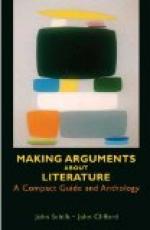On all questions as to construction of terms and burden of proof, it should be understood beforehand that the judges of a formal debate will heavily penalize anything like pettifogging or quibbling. The two sides should do their best to come to a “head-on” issue; and any attempt at standing on precise definition, or sharp practice in leading the other side away from the main question, should be held to be not playing the game. Where the judges are drawn from men of experience in affairs, as is usually the case, they will estimate such boyish smartnesses at their true value.
62. Technical Forms. The formal debates of school and college have certain forms and conventions which are partly based on parliamentary procedure, partly have been worked out to make these debates more interesting and better as practice; and there are certain preliminary arrangements that improve debating both as intellectual training and as fun. I shall speak first of the forms and conventions.
In debates in school and college it is usual to have two or three on a side, and for good reasons. In the first place, the labor of working up the subject is shared, and it is better fun working with some one else. Then, in the debate itself there is more variety. In class debates there are usually two speakers on each side, with provision of time for several four- or five-minute speeches from the floor before the closing speeches in rebuttal.[64] If there are as many speakers as this a two-hour period must be allowed. This allotment of time will naturally be adapted to special conditions; as, for example, where it is desirable that there shall be more speakers from the floor, or where it is desired to give the whole time to the regular debaters. In important intercollegiate debates there are usually three speakers, each of whom has ten minutes for his main speech and five minutes for rebuttal. This arrangement varies greatly, however, in different places, and not infrequently there is only one speech in rebuttal. The affirmative is usually given the last speech, on the theory that it is a disadvantage to have to open the debate. Obviously, however, in practice the reverse may often be true, since a skillful speech in opening may largely determine the course of the debate; and for this reason many debating societies and colleges allow the closing speech to the negative. It is wise not to look on any of these rules as inviolable.[65]
The distribution of the points between the speakers on a side should be made beforehand, but always with the understanding that the exigencies of the debate may upset the arrangement. We shall see presently the advantage there is in having each member of a “team” prepared to defend all the points on his side. The only speech for which a fixed program can be made beforehand is the first speech on the affirmative: obviously this must at any rate expound the main facts which the audience must know in order to understand the speeches that follow.




